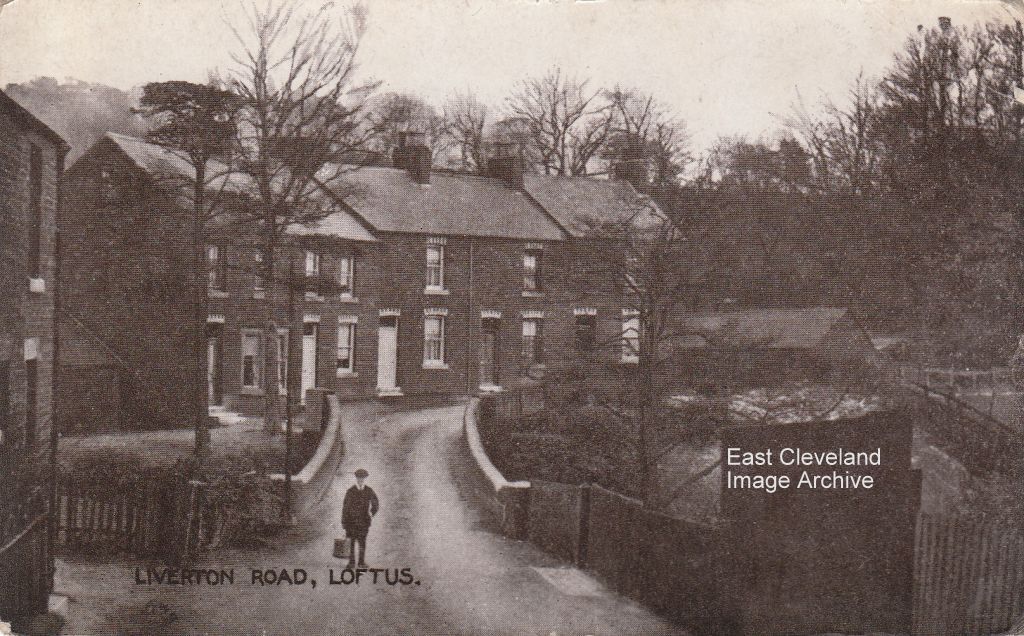
A postcard view of Liverton Road, Loftus, complete with ubiquitous urchin! This from the studio of John Thomas Ross – photographer and postcard publisher of Whitby – whose postcards are now much sought after.
Image courtesy of Ruth Wilcock.
|
|
||
|
A postcard view of Liverton Road, Loftus, complete with ubiquitous urchin! This from the studio of John Thomas Ross – photographer and postcard publisher of Whitby – whose postcards are now much sought after.
A different view of Liverton Road taken about 1929; a lovely photograph.
Hartley’s Field must have been where the houses in Gaskell Lane now stand, so-called as the Miller at Loftus Mill for many years was Jonathan Hartley. The view over the millpond and mill looks up towards the back of Zetland Road. I have just realised that the scaffolding, top left, would have been on the Congregational Church. The postcard produced by T.C. Booth of Loftus was posted in September, 1906. Image courtesy of Jean Hall.
There was me thinking we didn’t have a picture of Loftus Mill and there was one lurking in the cabinet all along!
A lovely picture of the mill with the pond in the foreground and the reflections in the pond make this place look idyllic. This hand tinted postcard in the Auty series gives a view of Loftus Mill across the mill pond, an idyllic image, with an impressive pink (sunset?) glow behind the buildings backing the Mill. Image courtesy of John G. Hannah.
The winter of 1906 was when this postcard view was taken and what a lovely photograph it is; the reflections in the pond are beautiful. Image courtesy of Pauline Ovington.
This postcard image of Loftus Mill is by John Thomas Ross – a well-known Whitby photographer – he possibly even met John Sanderson who was miller of Loftus Mill in 1871 census. John Sanderson was married to Mary Welford. Image courtesy of Ruth Wilcock and thanks to Ann Wilkinson for the information.
This coloured view of the mill was posted in 1905. The picture has been taken from the field above the millpond, and the rear of Odd-Fellows Hall can be clearly seen in the background. Image courtesy of Jean Hall.
This is a more unusual view of Loftus, looking over the mill and Liverton Road, with the Station Hotel standing out and Liverton Mines just visible in the background, taken from a postcard postmarked 2nd January 1905. Image courtesy of Jean Hall.
Here is another first, we had previously no other photographs of the foundry at Loftus. Do you have any to loan us please? Eric Johnson comments: ”An interesting view of the cupola melting furnace at the foundry, apparently being demolished. Three men are on the charging platform, the charging door on the cupola is open where the charge of pig iron/coke/limestone was introduced. To the right is a hoist on a large beam (above the standing men), used to raise the charges to the platform. At the base of the cupola the air chest for the blast around the cupola can be seen, with air pipe disconnected. Standing on 4 legs, the cupola probably had a drop bottom for emptying slag etc after the days run. The foundry originally owned by Robinson Brothers who produced farm implements, ploughs, etc. They also cast drain covers and gulleys, many of which can still be seen on the streets of East Cleveland. I have seen one at Piercebridge, Co. Durham. A speciality (unique?) were the cast iron gravestones, seen in the old cemetery. Robinson Bros were regular exhibitors at the Wool Fairs in the Market Place, Loftus. Old images show many of their products and warehouse next to the present day Post Office. I believe the foundry was taken over by Tinsley & Co. and is now used by Steve Whitlock.” Bill Tinsley tells us: ”Zetland foundry was owned by my grandfather until his death in the late 1930s. My father was a mining engineer with Richard Sutcliff in Horbury near Wakefield who sold a half-share to a manager who continued to run the foundry until around 1950. I spent a lot of time there as a child with my grandfather watching and getting in the way but even as a 7 or 8 year old I learned quite a lot about casting and machining methods There was a small machine shop at the far end of the buildings.” Bill also tells us: ”The cast iron railings round Saltburn Bandstand were made by grandfather at Zetland Foundry in the mid thirties but unfortunately removed early in Second World War and melted down for the war effort. Incidentally Thomas Tinsley was apprenticed to John Wood and Co (Steam engine and winch manufacturers in Lancashire) in July 1881.The papers which I still have includes phrases “Shall not wast the goods of his masters,Shall not frequent taverns or playhouses,or contract matrimony”.The apprentiship was for “Engine Fitting”. He later went on to be chief engineer at Nostel mine nr. Wakefield before buying Zetland Foundry. I have 3 photographs taken in 1970 when I last went there,one showing a similar view with the cupula removed, but just possible to see part of the words Zetland Foundry on the hoist beam. Another showing the brass name plate (Thos Tinsley & Son) on the old office door and the third showing his house in Saltburn.” Photograph courtesy of Keith Bowers and thanks to Eric and Bill Tinsley for the updates. |
||
Recent Comments